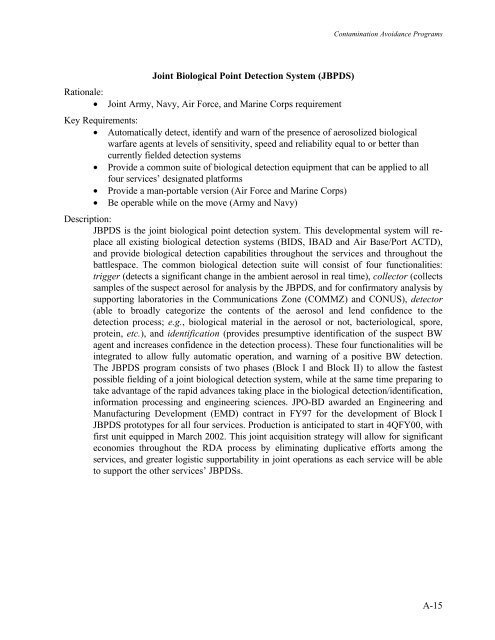Nuclear/Biological/Chemical (NBC) Defense - Federation of ...
Nuclear/Biological/Chemical (NBC) Defense - Federation of ...
Nuclear/Biological/Chemical (NBC) Defense - Federation of ...
Create successful ePaper yourself
Turn your PDF publications into a flip-book with our unique Google optimized e-Paper software.
Joint <strong>Biological</strong> Point Detection System (JBPDS)<br />
Rationale:<br />
• Joint Army, Navy, Air Force, and Marine Corps requirement<br />
Contamination Avoidance Programs<br />
Key Requirements:<br />
• Automatically detect, identify and warn <strong>of</strong> the presence <strong>of</strong> aerosolized biological<br />
warfare agents at levels <strong>of</strong> sensitivity, speed and reliability equal to or better than<br />
currently fielded detection systems<br />
• Provide a common suite <strong>of</strong> biological detection equipment that can be applied to all<br />
four services’ designated platforms<br />
• Provide a man-portable version (Air Force and Marine Corps)<br />
• Be operable while on the move (Army and Navy)<br />
Description:<br />
JBPDS is the joint biological point detection system. This developmental system will replace<br />
all existing biological detection systems (BIDS, IBAD and Air Base/Port ACTD),<br />
and provide biological detection capabilities throughout the services and throughout the<br />
battlespace. The common biological detection suite will consist <strong>of</strong> four functionalities:<br />
trigger (detects a significant change in the ambient aerosol in real time), collector (collects<br />
samples <strong>of</strong> the suspect aerosol for analysis by the JBPDS, and for confirmatory analysis by<br />
supporting laboratories in the Communications Zone (COMMZ) and CONUS), detector<br />
(able to broadly categorize the contents <strong>of</strong> the aerosol and lend confidence to the<br />
detection process; e.g., biological material in the aerosol or not, bacteriological, spore,<br />
protein, etc.), and identification (provides presumptive identification <strong>of</strong> the suspect BW<br />
agent and increases confidence in the detection process). These four functionalities will be<br />
integrated to allow fully automatic operation, and warning <strong>of</strong> a positive BW detection.<br />
The JBPDS program consists <strong>of</strong> two phases (Block I and Block II) to allow the fastest<br />
possible fielding <strong>of</strong> a joint biological detection system, while at the same time preparing to<br />
take advantage <strong>of</strong> the rapid advances taking place in the biological detection/identification,<br />
information processing and engineering sciences. JPO-BD awarded an Engineering and<br />
Manufacturing Development (EMD) contract in FY97 for the development <strong>of</strong> Block I<br />
JBPDS prototypes for all four services. Production is anticipated to start in 4QFY00, with<br />
first unit equipped in March 2002. This joint acquisition strategy will allow for significant<br />
economies throughout the RDA process by eliminating duplicative efforts among the<br />
services, and greater logistic supportability in joint operations as each service will be able<br />
to support the other services’ JBPDSs.<br />
A-15
















